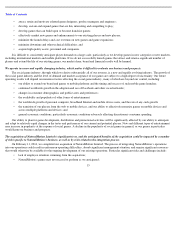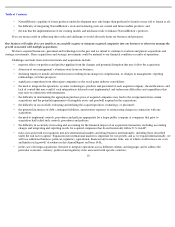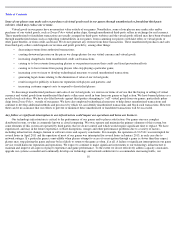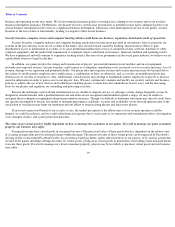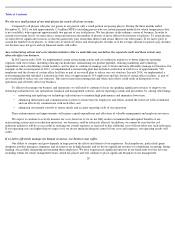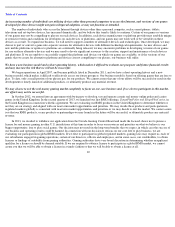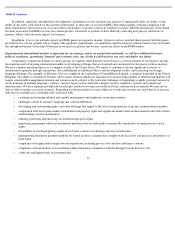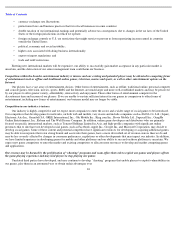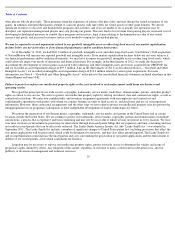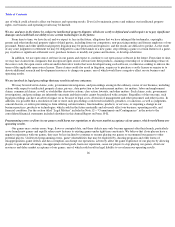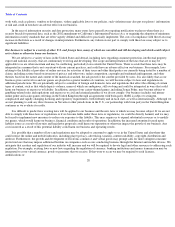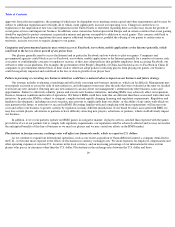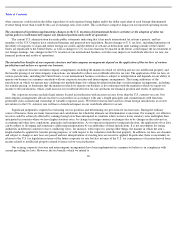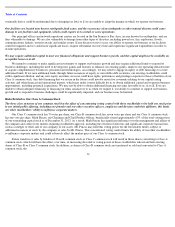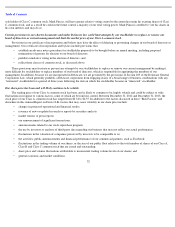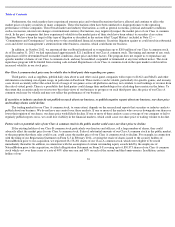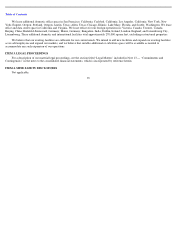Zynga 2013 Annual Report Download - page 29
Download and view the complete annual report
Please find page 29 of the 2013 Zynga annual report below. You can navigate through the pages in the report by either clicking on the pages listed below, or by using the keyword search tool below to find specific information within the annual report.
Table of Contents
other players who do play fairly. These programs harm the experience of players who play fairly and may disrupt the virtual economies of our
games. In addition, unrelated third parties attempt to scam our players with fake offers for virtual goods or other game benefits. We devote
significant resources to discover and disable these programs and activities, and if we are unable to do so quickly our operations may be
disrupted, our reputation damaged and players may stop playing our games. This may lead to lost revenue from paying players, increased cost of
developing technological measures to combat these programs and activities, legal claims relating to the diminution in value of our virtual
currency and goods, and increased customer service costs needed to respond to dissatisfied players.
We may be required to record impairment related to our goodwill, intangible assets or other long-lived assets if our market capitalization
declines below our net asset value or if our financial performance and/or condition deteriorates.
As of December 31, 2013, we had $621.2 million of goodwill, intangible assets and other long-lived assets. Our February 2014 acquisition
of NaturalMotion will increase our reported goodwill and intangible assets. If our market capitalization declines below our net asset value or if
our financial performance and/or condition deteriorates, we may have to impair our goodwill, intangible assets or other long-lived assets, which
could adversely impact our results of operations and financial position. For example, in the third quarter of 2012, we made the decision to
discontinue the development of certain games associated with technology and other intangible assets previously acquired from OMGPOP, Inc.
and we recorded an asset impairment charge of $95.5 million. And, in the third quarter of 2013 (as described in Note 6—“Goodwill and Other
Intangible Assets”) we recorded an intangible asset impairment charge of $10.2 million related to various prior acquisitions. For more
information, see Note 6 – “Goodwill and Other Intangible Assets”
in the notes to the consolidated financial statements included elsewhere in this
Annual Report on Form 10-K.
Failure to protect or enforce our intellectual property rights or the costs involved in such enforcement could harm our business and
operating results.
We regard the protection of our trade secrets, copyrights, trademarks, service marks, trade dress, domain names, patents, and other product
rights as critical to our success. We strive to protect our intellectual property rights by relying on federal, state and common law rights, as well as
contractual restrictions. We enter into confidentiality and invention assignment agreements with our employees and contractors and
confidentiality agreements with parties with whom we conduct business in order to limit access to, and disclosure and use of, our proprietary
information. However, these contractual arrangements and the other steps we have taken to protect our intellectual property may not prevent the
misappropriation of our proprietary information or deter independent development of similar technologies by others.
We pursue the registration of our domain names, copyrights, trademarks, service marks, and patents in the United States and in certain
locations outside the United States. We are seeking to protect our trademarks, service marks, copyrights, patents and domain names in multiple
jurisdictions, a process that is expensive and time
-consuming and may not be successful or which we may not pursue in every location. We may,
over time, increase our investment in protecting our innovations through increased patent filings that are expensive and time-
consuming and may
not result in issued patents that can be effectively enforced. The Leahy-Smith America Invents Act (the “Leahy-Smith Act”) was adopted in
September 2011. The Leahy-Smith Act includes a number of significant changes to United States patent law, including provisions that affect the
way patent applications will be prosecuted, which could be detrimental to investors, and may also affect patent litigation. The Leahy-Smith Act
and its implementation could increase the uncertainties and costs surrounding the prosecution of our patent applications and the enforcement or
defense of our issued patents, all of which could harm our business.
Litigation may be necessary to enforce our intellectual property rights, protect our trade secrets or determine the validity and scope of
proprietary rights claimed by others. Any litigation of this nature, regardless of outcome or merit, could result in substantial costs, adverse
publicity or diversion of management and technical resources,
25


